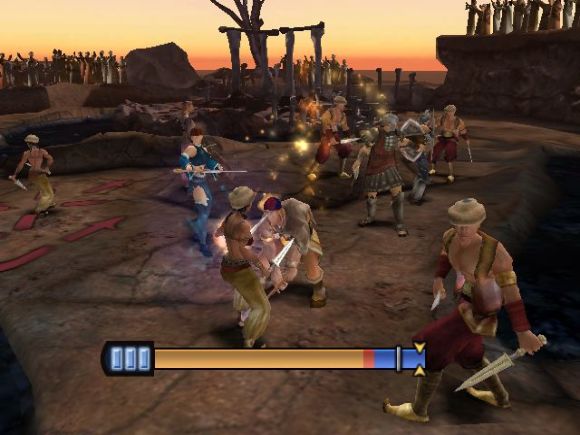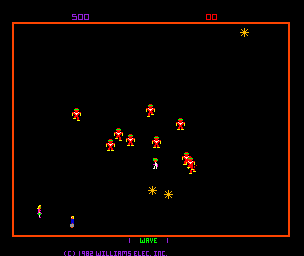Metamechanics
Mar 20, 2004 · peterb · 6 minute readGames
Game mechanics: the underlying rules and goals of a game. How do you decide what a player is allowed to do? When has a player won? How do player actions affect the game? The mechanics of a game are part of a game that is not narrative.
Some basic game mechanics:
- Run around in a circle; first one to finish wins. (all racing games)
- Kill everyone else and/or capture the flag (most FPSs)
- Move the ball to the scoring zone the most times (sports games)
- Capture and hold victory points (war games)
- Wager and win tokens (gambling games)
Compound games exist: Get the ball in the goal while killing everyone (Deathrow). Run around in a circle while killing everyone (Wipeout XL, Quantum Redshift). There are plenty more. What I’ve been thinking about today is not so much mechanics in the sense of the specific ways games play, as in these examples, but in what I think of as “meta-mechanics,” the classes that the rules themselves fall into. For example…
[
Malaysian circuit, Formula De](http://www.descartes- editeur.com/cata/form/sepang.jpg)
Since it’s the eve of the Malaysian Grand Prix, let’s look at two Formula 1 board games: Carabande and Formula De. Both games involve going around a track, with the first to finish the winner. but the metamechanics are totally different. In Carabande, the player flicks his “car” piece with his finger and tries to carom it around the track, while in Formula De he chooses a gear and rolls a die corresponding to that gear, then moves the car the number of spaces indicated by the die. Carabande relies on the skill and dexterity of the player, Formula De makes no such requirement.

Computer Ambush
That’s a fundamental distinction, and one that we see not only in board games – board games that require dexterity, while not unheard of, are probably more the exception than the rule – but also in video games. A first-person shooter Counterstrike and SSI’s Squad Leader-like Apple II game Computer Ambush tell a very similar narrative tale, but the mechanics could not be more different: real-time, single-avatar control of one member of a team where victory is determined by dexterity versus turn-based control of an entire team where victory is determined by careful plotting of tactical movement. We can even find games that fall in the middle: in Close Combat the default mode is semi-real time. In video games, this decision might be the most fundamental design question: some people prefer only one mechanic over another. Some strategy gamers won’t even touch a game if it requires any manual dexterity at all.
A similar decision is whether there is a role for random chance in a game. A game such as chess, checkers, or go is a “pure” game; the outcome is determined entirely by where the pieces are placed. On the other side of the spectrum would be Candyland, where the player actually has no control whatsoever over his move, and just obeys the random chance of the card he pulled from the stack. Many in-between shades exist, from The Game of Life (where you get to make essentially one decision: “Go to college” or “Don’t go to college”) to Monopoly (where in the early part of the game you can decide whether to purchase or not purchase each property you randomly land on) to The Settlers of Catan where you make early wagers on probability and make non-random moves which will provide payouts later (or not) based on a die roll. There is a school of ludological snobbery that says that “pure” games that have no randomness – such as chess, go, and checkers – are inherently superior to games with a random element. The logic here seems to go something like: games are a competition, and if I can’t prove my superiority every time by applying the power of my gigantic brain then the game sucks. I think that’s clearly wrong – randomness can have a place in games, just like in life. De gustibus non disputandum est.
[
Gladius
](http://www.tleaves.com/weblog/images/articles/gladius.jpg)
It is an increasingly common trope in videogames to let the player substitute dexterity for randomness. For example, in Gladius, a well-designed tactical combat game, the player moves his pieces around an arena and chooses from a variety of attacks. There’s an option to have the attack’s success or failure be determined by a die roll (which would be the likely method of resolution if Gladius were a board game), but the default mode is io display a “skill bar.” The game requires the player to press buttons on the controller in a certain pattern or with a certain rhythm. If the player completely muffs it, the piece she is controlling misses its opponent. If the player gets it right, the piece hits. If the player gets the rhythm just so, her piece performs a “critical hit” for extra damage. Many of the execrable Final Fantasy games use a variant on this system as well.

Robotron 2084
Most video games, for better or for worse, have adopted a model where the abilities of the player’s avatar change over time, either by granting the avatar more power directly or by teaching the player new ways of manipulating her avatar. This is a fairly significant change from the early days of game design. In Pong a player’s paddle is static throughout the life of the game. The hero in Robotron 2084 never gains additional weapons or more speed. Today, I think you’d be hard pressed to find a game where it’s not true that either the player’s character gains power or skill (for example, by acquiring better weapons or armor in a shooter, or more accuracy in a golf or tennis game) or the player herself is led to have more skill (for example, introducing the ubiquitous “double jump” in any platform game you care to name.) These aren’t purely videogame innovations, of course – in chess, a pawn can become a queen, after all – but it’s interesting that their presence has become the rule. Perhaps the only exception that comes immediately to mind is in team-based sports games such as football, and those are somewhat prevented from increasing the skill of their avatars by their desire to claim to accurately model real teams and players.
What other metamechanics can we identify? Why do some “strategy” gamers so vehemently prefer randomness to dexterity, when that randomness is only a part of the genre because doing more sophisticated modeling in a boardgame context is ponderous? Shouldn’t the “roll a die” method of determining an outcome in RPGs and strategy games be outmoded, now that we have hyperintelligent transdimensional computers to do the hard modeling work for us? Is “roll a die” still the preferred method of combat resolution simply because it’s easier for developers to implement, and we’re all lazy?
Additional Resources
Score points by moving your piece into the target areas below and clicking.
- Eric observes that talking about these things can be hard.
- There are plenty of people that think about this stuff more carefully than I do.
- Everyone knows where to get videogames, but if you have no local board-gaming shop, you can get great board games from Funagain.
- It bothers me that Carabande (and its inferior remake) are so expensive.